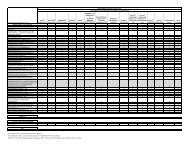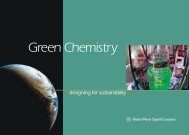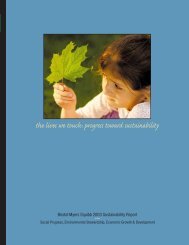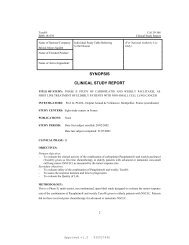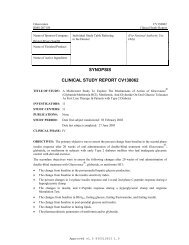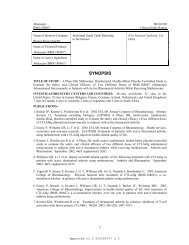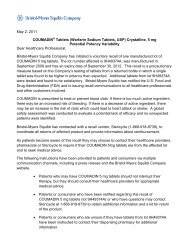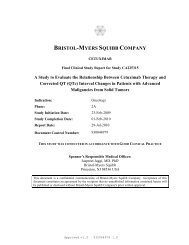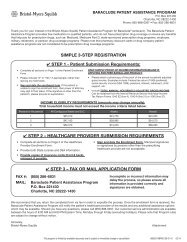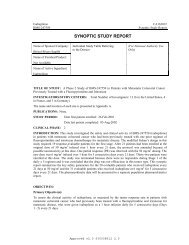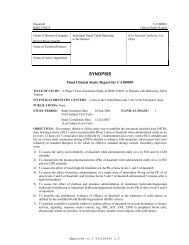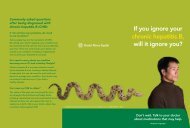BRISTOL-MYERS SQUIBB COMPANY
BRISTOL-MYERS SQUIBB COMPANY
BRISTOL-MYERS SQUIBB COMPANY
- No tags were found...
Create successful ePaper yourself
Turn your PDF publications into a flip-book with our unique Google optimized e-Paper software.
<strong>BRISTOL</strong>-<strong>MYERS</strong> <strong>SQUIBB</strong> <strong>COMPANY</strong><br />
ENTECAVIR<br />
Final Clinical Study Report for Study AI463050<br />
ABBREVIATED REPORT<br />
A STUDY OF THE SAFETY AND ANTI-VIRAL ACTIVITY OF<br />
OPEN-LABEL ENTECAVIR IN ADULTS WITH CHRONIC<br />
HEPATITIS B INFECTION WHO HAVE COMPLETED DOSING IN<br />
A PREVIOUS PHASE II/III STUDY IN CHINA<br />
Indication:<br />
Phase:<br />
Study Initiation Date:<br />
Study Completion Date:<br />
Report Date:<br />
Chronic HBV in Adults<br />
3b<br />
17-May-2004<br />
28-Aug-2007<br />
08-Apr-2008<br />
Document Control Number: 930027096<br />
Previous Version(s) of this<br />
Report:<br />
None<br />
THIS STUDY WAS CONDUCTED IN ACCORDANCE WITH GOOD CLINICAL PRACTICE<br />
Sponsor’s Responsible Medical Officer:<br />
Cyril C Llamoso, MD<br />
Bristol-Myers Squibb Research and Development<br />
5 Research Parkway, Wallingford, CT 06492<br />
This document is a confidential communication of Bristol-Myers Squibb Company. Acceptance of this<br />
document constitutes an agreement by the recipient that no unpublished information contained herein will<br />
be published or disclosed without Bristol-Myers Squibb Company's prior written approval.<br />
Approved v 1.0<br />
930027096 1.0
Entecavir<br />
BMS-200475<br />
Name of Sponsor/Company:<br />
Bristol-Myers Squibb<br />
Name of Finished Product:<br />
Baraclude ®<br />
Name of Active Ingredient:<br />
entecavir<br />
Individual Study Table Referring<br />
to the Dossier<br />
AI463050<br />
Final Clinical Study Report<br />
(For National Authority Use<br />
Only)<br />
SYNOPSIS<br />
Final Clinical Study Report for Study AI463050<br />
ABBREVIATED REPORT<br />
TITLE OF STUDY: A Study of the Safety and Anti-Viral Activity of Open-Label Entecavir in Adults<br />
with Chronic Hepatitis B Infection Who Have Completed Dosing in a Previous Phase II/III Study in China<br />
INVESTIGATORS/STUDY CENTERS: 26 sites in China<br />
PUBLICATIONS: None<br />
STUDY PERIOD: Study Initiation Date: 17-May-2004<br />
CLINICAL PHASE: 3b<br />
Study Completion Date: 28-Aug-2007<br />
INTRODUCTION: Study AI463050 was a rollover study designed to provide open-label entecavir (ETV)<br />
to subjects who had completed the required dosing period in previous ETV Phase 2 or 3 studies in China<br />
and were assessed by the investigators as likely to benefit from additional therapy for treatment of their<br />
hepatitis B virus (HBV) infection. The interim clinical study report (CSR), completed in May 2007,<br />
presents safety and efficacy results that occurred during the on-treatment period. This final CSR presents<br />
the key observations in the analyses related to the safety and antiviral activity of ETV in adults with<br />
chronic HBV infection that occurred during the off-treatment phase of the study.<br />
OBJECTIVES: The primary objective was to assess the safety of oral ETV (0.5 or 1.0 mg once daily<br />
[QD]) as measured by the number and percentage of subjects with adverse events (AEs) and laboratory<br />
abnormalities.<br />
METHODOLOGY: This was a Phase 3b rollover study designed to provide open-label ETV to subjects<br />
who had received study therapy in previous ETV Phase 2 or 3 studies in China:<br />
• Study AI463012 was a study in nucleoside-naive subjects comparing the safety and anti-viral activity<br />
of 2 doses of ETV (0.1 and 0.5 mg QD) to placebo given for 28 days during the blinded dosing phase.<br />
After a 56 day post-dosing period, all eligible subjects received open-label ETV 0.5 mg QD for up to<br />
48 weeks<br />
• Study AI463056 was a study in subjects who had failed previous lamivudine (LVD) treatment that<br />
evaluated the safety and anti-viral activity of ETV 1 mg QD administered for 12 weeks compared to<br />
placebo. After completing the blinded dosing phase, all eligible subjects were to receive open-label<br />
ETV 1.0 mg QD for 36 weeks<br />
• Study AI463023 was a study in nucleoside-naive subjects comparing the safety and anti-viral activity<br />
of ETV 0.5 mg QD to LVD 100 mg QD for up to 96 weeks.<br />
2<br />
Approved v 1.0<br />
930027096 1.0
Entecavir<br />
BMS-200475<br />
AI463050<br />
Final Clinical Study Report<br />
In Study AI463050, a complete response was defined as HBV deoxyribonucleic acid (DNA) by polymerase<br />
chain reaction (PCR) assay < 10 4 copies/mL plus seroconversion on 2 sequential measurements drawn at<br />
least 24 weeks apart for subjects hepatitis B e antigen (HBeAg) positive at baseline and as HBV DNA by<br />
PCR assay < 10 4 copies/mL and normal alanine aminotransferase (ALT) (< 1.25 times upper limit of<br />
normal [ULN]) on 2 sequential measurements drawn at least 24 weeks apart for subjects HBeAg negative<br />
at baseline. Subjects who achieved a complete response were to discontinue study drug and be followed off<br />
anti-HBV therapy for 24 weeks post-dosing. Subjects who relapsed during the 24-week post-dosing phase<br />
could resume dosing of ETV or begin alternative anti-HBV therapy as recommended by their physician.<br />
Relapse (defined as HBV DNA by PCR assay ≥ 10 4 copies/mL and/or HBeAg positive for subjects HBeAg<br />
positive at baseline and as HBV DNA by PCR assay ≥ 10 4 copies/mL and/or ALT ≥ 1.5 times ULN for<br />
subjects HBeAg negative at baseline) must have been confirmed on 2 successive determinations at least 2<br />
weeks apart.<br />
NUMBER OF SUBJECTS (Planned and Analyzed): Overall, 139 of 575 subjects (24%) entered the<br />
post-dosing follow-up phase of Study AI463050 (8, 31, 59, and 41 in the ETV 012, ETV 023, LVD 023,<br />
and ETV 056 cohorts, respectively). During the post-dosing phase, 27 subjects who relapsed were<br />
re-treated.<br />
DIAGNOSIS AND MAIN CRITERIA FOR INCLUSION: Subjects who had completed the required<br />
dosing period in a previous ETV Phase 2 or 3 study in China (Studies AI463012, AI463023, or AI463056),<br />
met the criteria for enrollment in Study AI463050, and had been assessed by the investigators as likely to<br />
benefit from additional therapy for treatment of their HBV infection.<br />
TEST PRODUCT, DOSE AND MODE OF ADMINISTRATION, DURATION OF TREATMENT,<br />
BATCH NUMBERS: One 0.5-mg ETV tablet QD (for subjects enrolling from Study AI463012) or 2<br />
0.5-mg ETV tablets for a total of 1.0 mg QD (for subjects enrolling from Studies AI463056 and<br />
AI463023). Batch nos. were 3C73622 and 3M56459.<br />
REFERENCE THERAPY, DOSE AND MODE OF ADMINISTRATION, DURATION OF<br />
TREATMENT, BATCH NUMBERS: Not applicable<br />
CRITERIA FOR EVALUATION:<br />
Efficacy: The sustained response at 24 weeks off-treatment was assessed for subjects who had achieved a<br />
complete response at end of dosing (EOD). The following endpoints were included: (1) HBV DNA < 300<br />
copies/mL; (2) HBV DNA < 10,000 copies/mL; (3) ALT ≤ 1 x ULN; (4) loss of HBeAg; and (5) HBeAg<br />
seroconversion.<br />
Safety: All subjects who received at least 1 dose of ETV during the treatment phase and entered the<br />
off-treatment phase were to be evaluated for safety, including the evaluation of AEs and laboratory test<br />
results (hematology, biochemistry, and urinalysis).<br />
STATISTICAL CONSIDERATIONS: The sustained response at 24 weeks off-treatment follow-up was<br />
assessed for subjects who achieved a complete response at EOD. For each of the selected endpoints, the<br />
analysis was based on complete responders who had reached the endpoint at EOD. Subjects were classified<br />
as failures if they (1) lost the endpoint; (2) did not complete the 24-week follow-up; or (3) did not have a<br />
measurement in the analysis window. Safety analyses tabulate the proportion of subjects with events during<br />
off-treatment follow-up.<br />
SUMMARY OF RESULTS:<br />
Disposition, Demographics, and Other Pertinent Baseline Characteristics: Demographics and other<br />
background characteristics are summarized in the Study AI463050 interim CSR. No additional analyses<br />
were conducted for the subjects with off-treatment follow-up data or re-treatment data.<br />
3<br />
Approved v 1.0<br />
930027096 1.0
Entecavir<br />
BMS-200475<br />
AI463050<br />
Final Clinical Study Report<br />
Efficacy Results: Week 24 sustained response for HBV DNA < 300 copies and ALT ≤ 1 ULN was higher<br />
among HBeAg-positive subjects (24% and 51%, respectively) vs. HBeAg-negative subjects (15% and 41%,<br />
respectively) (Table 1).<br />
Table 1:<br />
Sustained Response at Week 24 Off Treatment<br />
Responders/Evaluable (%)<br />
LVD 023 +<br />
Sustained Response at Week 24 Off Treatment<br />
Baseline HBeAg Status in Parent Study<br />
ETV 023<br />
N = 29<br />
ETV 056<br />
N=82<br />
Total<br />
N=118<br />
HBV DNA < 300 copies/mL<br />
HBeAg + 2/21 (10) 14/49 (29) 18/76 (24)<br />
HBeAg - 1/5 (20) 4/28 (14) 5/34 (15)<br />
HBV DNA < 10000 copies/mL<br />
HBeAg + 7/24 (29) 28/53 (53) 38/83 (46)<br />
HBeAg - 2/5 (40) 8/29 (28) 10/35 (29)<br />
Loss of HBeAg<br />
HBeAg + 10/24 (42) 32/53 (60) 46/83 (55)<br />
HBeAg seroconversion<br />
HBeAg + 10/20 (50) 26/42 (62) 40/68 (59)<br />
ALT ≤ 1 x ULN<br />
HBeAg + 9/24 (38) 29/51 (57) 41/80 (51)<br />
HBeAg - 2/4 (50) 11/29 (38) 13/34 (38)<br />
Safety Results: No deaths or malignancies were reported during the post-dosing or re-treatment periods.<br />
None of the 27 subjects who were re-treated discontinued study medication due to AEs. Nine of 137<br />
subjects (7%) experienced serious adverse events (SAEs) (ALT increased [6%], aspartate aminotransferase<br />
[AST] increased [3%], and abortion threatened [< 1%]). Five subjects (4%) experienced ALT flares, and all<br />
events occurred without selected clinical or laboratory events. Four subjects (3%) experienced hepatic<br />
SAEs with ALT flares and 2 subjects (1%) experienced hepatic SAEs without ALT flares.<br />
Off treatment, 29 of 137 subjects (21%) experienced AEs. AEs reported in > 1% of subjects included ALT<br />
increased and nasopharyngitis (9 subjects [7%] each) and AST increased and upper respiratory tract<br />
infection (4 subjects [3%] each).<br />
Nine of 27 re-treated subjects experienced AEs. AEs included ALT increased (5 subjects [19%]) and AST<br />
increased, decreased appetite, fatigue, hepatic pain (2 subjects [7%] each), and diarrhea, nasopharyngitis,<br />
rash, and vertigo (1 subject [4%] each).<br />
With the exception of increased serum ALT, most laboratory values were normal during the off-treatment<br />
phase, and few Grade 3-4 laboratory abnormalities were reported.<br />
CONCLUSIONS:<br />
• The overall safety profile of long-term treatment (up to 3 years) with ETV in this study was consistent<br />
with the safety profile established in both China and global Phase 2 or 3 studies<br />
• Over the course of the study, no deaths were reported. Two malignancies were reported, both during<br />
the treatment period<br />
• ALT flares observed during the off-treatment period were low<br />
4<br />
Approved v 1.0<br />
930027096 1.0
Entecavir<br />
BMS-200475<br />
AI463050<br />
Final Clinical Study Report<br />
• Durability of response up to 24 weeks was observed in a minority of both HBeAg-positive and<br />
HBeAg-negative subjects.<br />
DATE OF REPORT: 08-Apr-2008<br />
5<br />
Approved v 1.0<br />
930027096 1.0




